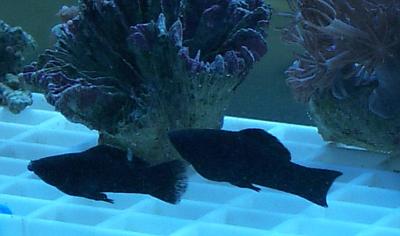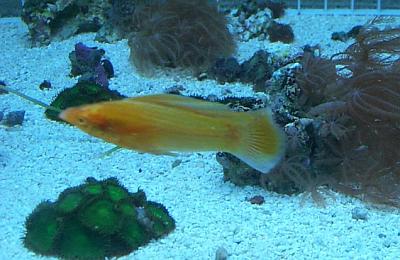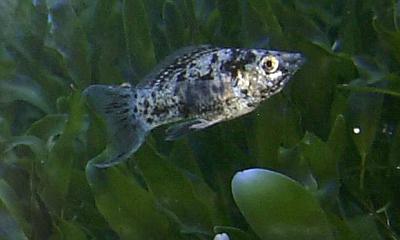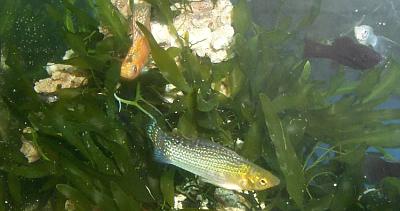
By Bob Goemans

There are now 'saltwater' Mollies available that are already raised in a seawater environment. They are bold micro and macroalgae grazers and make peaceful tankmates. My thanks to Sheila and Jeremy Sellinger of Saltwater Mollies for the following information and the attached photos of some of the available strains.
Dear Bob, Mollies are a group of fish that once occupied their own genus, Molliensia, which is now part of the genus Poecilia, and includes mollies and guppies. The most common mollies include Sailfin Mollies (P. latipinna, P. velifera) and the sphenops Molly (P. sphenops), also known as the Short-Finned Molly. Wild Sailfin mollies (P. latipinna), usually referred to as green sailfin mollies, are native to most of the southern coast of the USA, especially in brackish water. Other molly species are found in Central and South America.

Many of the various molly colors seen in pet shops are due to selective breeding that emphasized certain features and may have involved several species of mollies. Available marine varieties include the Green Sailfin Molly (wild), Silver Sailfin Molly, Black Sailfin Molly, Dalmation (Mottled) Sailfin Molly, Gold Sailfin Molly, Black Sphenops, Yucatan Mollies and others. The sailfin varieties tend to get larger than most others, - three to six inches long (7.5 - 15 cm), but are quite gentle with other fish. The Yucatan mollies tend to remain small, about two inches (5 cm).

Mollies are often portrayed as a difficult fish to maintain and are commonly only kept as a freshwater fish. They are supposed to require brackish water, high temperatures, special foods and frequent treatment for fungus and other infections. However, we have found mollies to be quite easy to keep and breed in the marine environment if you keep in mind a few essential aspects such as fairly good water quality, proper nutrition, and their temperature requirements. The salt tolerance of mollies allows them to live in water ranging from completely freshwater to completely marine, which makes mollies potentially compatible with a wide range of setups. This is fairly unusual, as most fish are compatible with only freshwater, brackish water or that of only saltwater environments. This ability allows mollies to live in a variety of coastal environments.

It is a misconception that acclimation to a marine environment must be done slowly over a period of at least several days to allow their bodies time to adjust and minimize stress. This is a theory that I have documented as being false, since we have developed an acclimation method that fully and successfully changes a molly from freshwater to marine in less than 3 hours.

Also a misconception is the idea that mollies require excellent water quality. This has been proven incorrect, at least as far as marine mollies are concerned. Our studies show that mollies correctly acclimated, and especially the offspring born in a salinity of 1.022-1.023, are a very hardy fish. In fact, they are even capable of surviving the break in period of a new marine aquarium (establishment of the nitrification cycle), thereby rendering them more useful than damselfish because of their mild temperament.
Also, the presence of many known molly illnesses has not been seen in any of our marine mollies. The only case of illness was seen in one of our first mollies. This fish displayed a noted disintegration of the mouth, but after 2-3 days of being fed a diet of mysis and brine shrimp the symptoms disappeared and never returned. This problem has not been repeated because we now feed all our mollies a complete marine diet. This is not to say that marine mollies are indestructible, but suggests it may be easier to maintain healthy mollies in a good, clean marine aquarium with a balanced diet.
Mollies are often the first fish in a community tank to show signs of being affected by an unbalanced aquarium, so they could be viewed as indicator species. A common rule of thumb in the freshwater hobby was that mollies required frequent water changes. However, we have found that our mollies thrive in healthy reef aquariums, where water changes are not required that often.
Nutrition wise, plants/algae, and other type green foods are absolutely necessary for good molly health. Caulerpa prolifera seems to be the best marine algae to sustain marine mollies. A second choice would be C. mexicana.
Mollies tend to prefer a temperature around 76 ° F, which is a good temperature for many other marine fish and plant species. Also keep in mind that mollies, especially sailfin mollies, tend to have long fins which may invite certain species to pick on the usually gentle mollies. For this reason mollies do best in a reef environment or a nonaggressive-type fish-only tank.
Of possible interest, we had a fish recently come into our shop with Marine Ich and my molly fry began to pick it off just like a cleaner fish! I'm not sure if this is normal for mollies, as it's the first time we have even seen such behavior, - interesting though! We should add that black feeder mollies are a great source of food for many marine carnivores, and they are available either alive or frozen.
The grace and beauty of mollies should be experienced by marine aquarists. A tank with live plants and mollies is hard to beat and not that difficult to maintain.
Visit our website (www.reeferrocks.com/saltwatermollies)for more information about the various morphs we have developed especially for marine aquariums or contact us directly via email (saltwatermollies@msn.com).
Sheila and Jeremy Sellinger
Saltwater Mollies
Aquatech
(Unfortunately as of 2/05 this page no longer exists, however, Saltwater Mollies are still available, however, a search of the web will be necessary to find them. Bob)